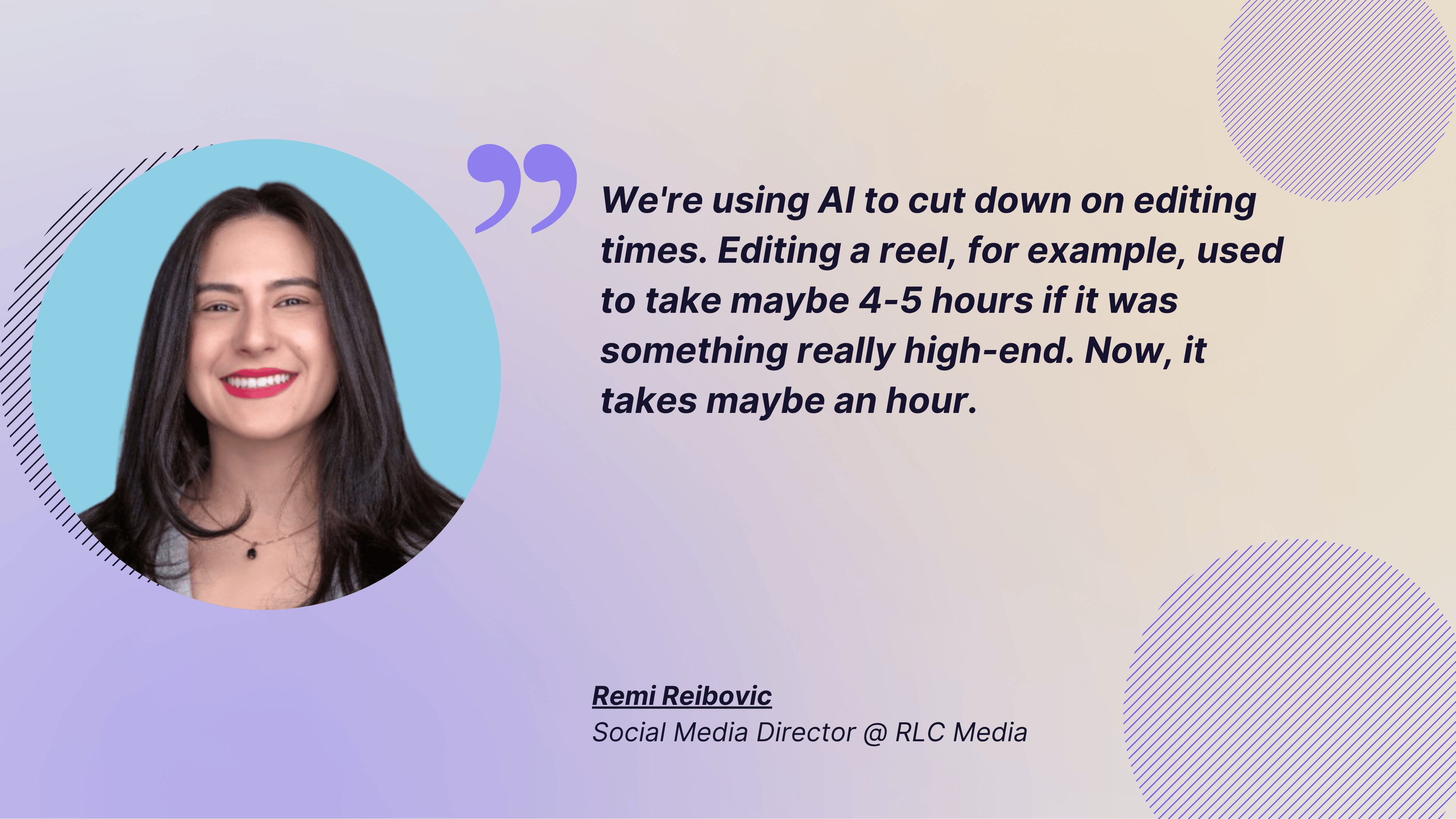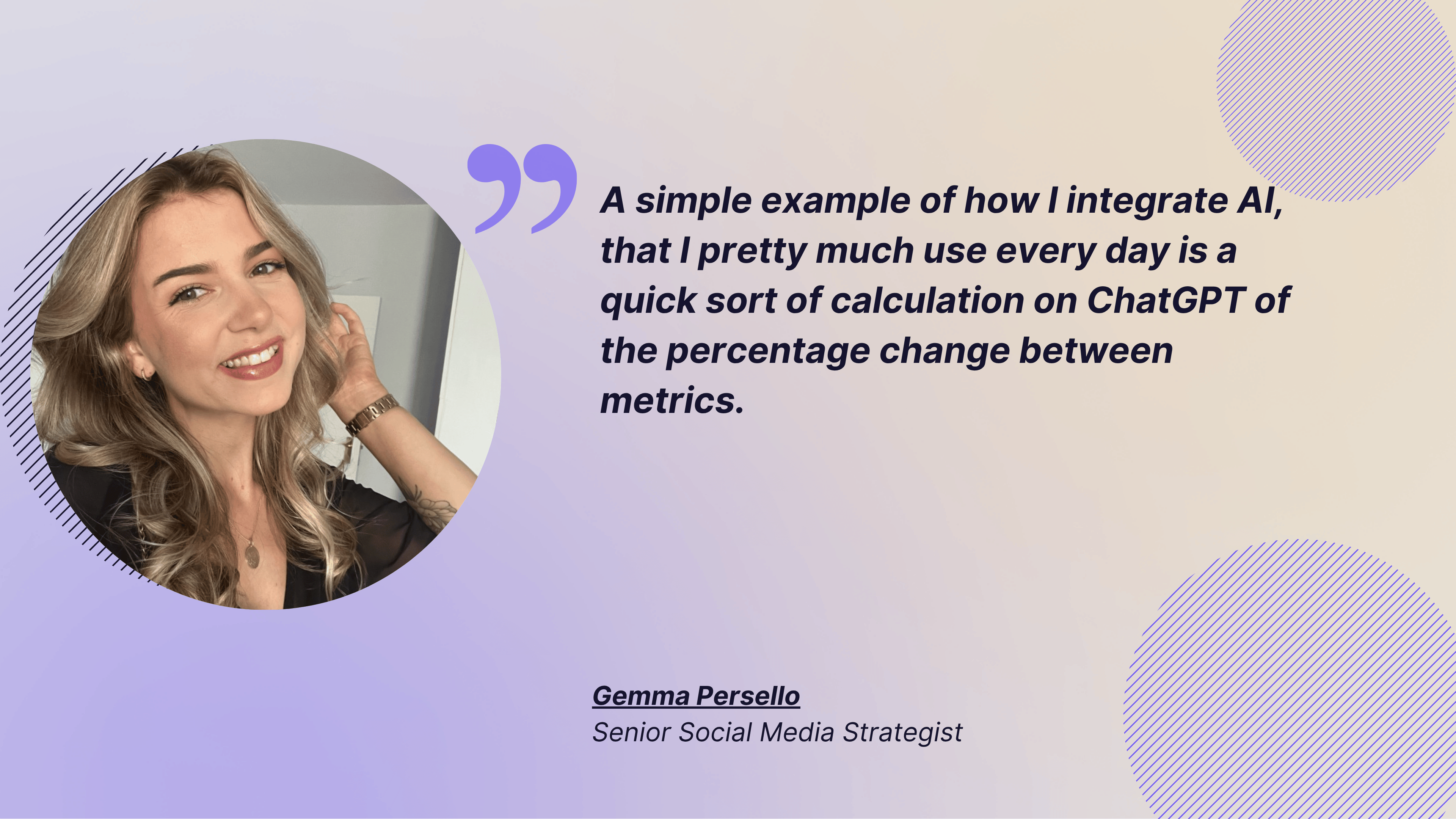100+ Actionable AI Prompts For Social Media To Help You Scale Your Efforts
Discover creative AI prompts for social media that boost engagement and inspire unique content. Transform your posts and easily drive more interactions.

You’ve seen the hype around using AI prompts for social media. So you open an AI tool and type in ‘’Make me a 30-day content calendar for Instagram for my SaaS business.
The results?
Vague, unfocused and far from your social media marketing goals.
Frustrated, you close ChatGPT and decide that AI is just not for you.
You’re not alone. Many people find AI misses the mark, while others use it proficiently to automate all their social media tasks. The difference isn’t the tool, it’s the AI prompts they use.
The better your AI prompt, the better your result.
Through this article, I'll cover what makes an effective AI prompt, where to use them in social media, and actionable prompts to get you started.
Key takeaways
-
How to use AI prompts for effective social media management? Use AI prompts strategically to batch content, maintain brand consistency, build engagement frameworks, and analyze performance so you can manage social media more efficiently and effectively.
-
Social media AI prompts categories that can help you streamline your workflow: Organize your workflow around four main AI prompt categories—content creation, strategy and planning, analytics and performance, and competitive analysis—to save time and improve results across all platforms.
-
How to measure prompt impact on KPIs? Track and compare the performance of AI-generated vs. human-generated content through A/B testing on defined KPIs like engagement, conversions, and reach to gauge prompt effectiveness.
How to use AI prompts for effective social media management?
An AI prompt is a question or an instruction you give to an AI tool to get it to do a specific task. The key: context and details matter. The more specific you are, the better results AI will generate.
The real value comes from feeding AI quality input.
As Malena Roche, senior strategy and insights consultant, aptly says, :
The output's gonna be as good as the input. Whatever you feed it is gonna be key in what you get back.
Now, let me show you how to actually use AI for social media.
Batch your content
Instead of asking your AI tool ‘what to post today’ (panic mode), I use it to map out a week or a month’s worth of content in one go.
My advice? Include multiple post types: educational carousels, behind-the-scenes content, conversation starters, and promotional posts.
Maintain a consistent brand voice across all platforms
Your content needs to work across different social media platforms - but different platforms require different approaches. LinkedIn rewards professional insights, Twitter is all about snappy content, and Instagram is a visual storytelling haven.
The challenge is to adapt your voice to each platform without sounding inconsistent or losing your brand identity.
AI streamlines this process and creates platform-specific content in your brand voice.
And then watch it mimic your tone, optimise content for each social platform, and send you posts that sound exactly like you.
Create a fool-proof engagement strategy
Managing content requires you to respond to feedback, complaints, repeat questions, and positive comments.
Here's what I do. Instead of responding to each comment individually (which sometimes gets quite tedious), I use AI to build response frameworks.
I start by feeding AI some of the frequent comments I get on my posts and ask it to give me different ways I can reply to them. Then I just use these templates for consistent, faster responses.
Analyse your performance data
Most content creators post, check likes and engagement, and move on. But take it from me, smart marketers analyse each post to identify patterns and improve results.
This is where AI excels.
Here's how I approach this. I feed an AI tool all of my data - which posts got high engagement, which flopped, which drove clicks, which generated shares - and ask it to conduct a content audit.
Then I start questioning and analyzing.
What topics got the best engagement, and which ones flopped? What type of content drew the most eyeballs from your audience? What kind of captions worked best? Which posting times got maximum engagement?
Social media AI prompts categories that can help you streamline your workflow
According to a 2024 survey, 38% of marketing professionals report that increased efficiency is the top benefit of using AI for social media. The key to unlocking this efficiency is knowing which social media prompts to use for specific tasks.
Below, you'll see the 4 main AI prompts categories I use for building a smarter social media management workflow.
AI prompts for social media content creation
I use AI to simplify the entire content pipeline - from single captions and video scripts to multi-slide carousels and complete post concepts. This way, I get optimised social media content in minutes instead of hours.
Here's what Remy Reibovic, fractional social media director, told our CMO, Adina Jipa, in a webinar they hosted together:
We're using AI to cut down on editing times. Editing a reel, for example, used to take maybe 4-5 hours if it was something really high-end. Now, it takes maybe an hour.

AI prompts for social media strategy & planning
AI prompts transform social media from ‘what do I post today?’ to ‘what’s my social media content strategy for the month?’
I use social media prompts on AI tools to build content calendars, plan synchronised social media campaigns across different platforms, identify content gaps in your current strategy, and develop audience engagement plans.
AI prompts for social media analytics & performance
AI social media prompts analyze your past performance data and determine what’s working and what isn’t.
Another way I use it is to identify top-performing topics, captions, content types, and posting times across platforms.
In the same webinar, Gemma Persello, senior social media strategist, said:
A simple example of how I integrate AI, that I pretty much use every day is a quick sort of calculation on ChatGPT of the percentage change between metrics.

AI prompts for competitive analysis
Lastly, but not least, I rely on AI social media prompts to analyze what my competitors are doing, what’s working for them, their social media content gaps, and where I can differentiate.
For me, this is an excellent way to find opportunities to outperform competitors.
And here's what Malene Roche, senior strategist & consultant is most excited about when it comes to AI in social media:
Predictive insights excite me the most. Just imagine AI spotting a trend before it hits its peak.

AI Prompt ideas for social media content creation
Let's start with the foundation: creating engaging content for each major platform. These prompts help you generate platform-specific content that resonates with your audience.
AI prompts for Instagram captions and posts
Instagram thrives on visual storytelling paired with compelling captions. Use these prompts to create content that drives engagement:
For product posts:
- "Write 5 Instagram captions for [product name] that highlight [key benefit]. Include a call-to-action and 2-3 relevant emojis. Target audience: [describe audience]."
- "Create a carousel post script (10 slides) explaining [topic/process]. Make each slide concise with a hook on slide 1 and CTA on slide 10."
- "Generate an Instagram caption that tells the story behind [product/service] in 150 words or less. Use a conversational tone and include a question to encourage comments."
For engagement-focused content:
- "Write 10 'This or That' Instagram Story prompts related to [industry/niche] that encourage audience interaction."
- "Create an Instagram caption for a user-generated content repost that thanks the creator, highlights why we love it, and encourages others to share. Include relevant hashtags."
- "Generate 5 educational carousel topics for [industry] that provide value and position us as thought leaders. Format as catchy titles."
For brand storytelling:
- "Write an Instagram caption sharing our brand's origin story in a way that emotionally connects with [target audience]. Include a vulnerability or challenge we overcame."
- "Create a behind-the-scenes post caption (150-200 words) showing our team/process. Make it authentic and relatable."
AI Prompts for LinkedIn professional content
LinkedIn requires a different approach—more professional, insight-driven, and thought-leadership oriented:
For thought leadership:
- "Write a LinkedIn post (1,300 characters) sharing a contrarian opinion about [industry trend]. Start with a hook, provide 3 supporting points, and end with a discussion question."
- "Create a LinkedIn article outline (5 sections) on [topic] that positions me as an expert. Include data points where statistics would strengthen the argument."
- "Generate a personal story post for LinkedIn about [professional challenge/lesson]. Make it vulnerable yet professional, around 200 words."
For company updates:
- "Write a LinkedIn announcement post for [company milestone/product launch]. Lead with the benefit to customers, include social proof if available, and add a compelling CTA."
- "Create 5 different angles to announce [news] on LinkedIn, each targeting a different audience segment: customers, industry peers, potential hires, investors, and partners."
For engagement content:
- "Generate 10 industry-specific poll questions for LinkedIn that spark debate and encourage comments."
- "Write a LinkedIn post analyzing [recent industry news/trend]. Provide a unique perspective in 150 words, then pose a question to the audience."
AI Prompts for TikTok Video Scripts
TikTok demands quick hooks and entertaining delivery. These prompts help structure short-form video content:
For educational content:
- "Write a 60-second TikTok script explaining [concept] to [target audience]. Start with a pattern interrupt hook, present 3 quick tips, and end with a CTA to follow for more."
- "Create a 'Did you know?' TikTok script about [surprising fact in your industry]. Make it conversational and include text overlay suggestions."
- "Generate a TikTok tutorial script showing how to [task/process] in 5 easy steps. Keep each step under 10 seconds of explanation."
For trending content:
- "Write a TikTok script adapting [trending audio/meme] to [your industry/product]. Make it funny and relatable while staying on-brand."
- "Create 5 TikTok video ideas using [current trend] to showcase [product/service benefits]. Include hook, body, and CTA for each."
For behind-the-scenes:
- "Write a TikTok script for 'A day in the life of [job title]' at our company. Make it entertaining with unexpected moments. 45-60 seconds."
- "Generate a TikTok script revealing [surprising fact about your business/industry]. Start with 'POV:' or 'Nobody talks about...' hook."
AI Prompts for Facebook engagement
Facebook favors meaningful conversations and community building:
For community building:
- "Write a Facebook post that asks our community to share their [experience/story related to your niche]. Make it personal and include why we're asking."
- "Create a Facebook poll about [topic] with 4 answer options that will generate discussion in comments. Include context in the post text."
- "Generate a 'Fill in the blank' Facebook post related to [topic] that encourages easy participation. Example: 'My favorite thing about [topic] is ______.'"
For value-driven content:
- "Write a Facebook post sharing 5 quick tips about [topic]. Format for easy scanning with emojis or numbers. Include why these tips matter."
- "Create a Facebook post promoting [blog article/resource] that highlights the 3 key takeaways readers will get. Make the value crystal clear."
For promotional content:
- "Write a soft-sell Facebook post for [product/service] that leads with a customer pain point, shares a brief customer success story, and includes a low-pressure CTA."
- "Generate a Facebook event announcement post that creates FOMO while providing clear details: what, when, where, why attend, and how to register."
AI Prompts for Twitter/X Threads
Twitter threads allow for deeper storytelling while maintaining the platform's concise nature:
For educational threads:
- "Create a 10-tweet thread explaining [complex topic] in simple terms. Tweet 1 should be a hook, tweets 2-9 should each cover one key point, and tweet 10 should summarize with a CTA."
- "Write a Twitter thread breaking down [case study/example]. Include specific numbers, what worked, what didn't, and key lessons. 7-8 tweets."
- "Generate a 'Myth vs Reality' Twitter thread about [industry topic]. Cover 5 common myths. Format: Myth: / Reality: / Why it matters:"
For engagement threads:
- "Create a 'Unpopular opinion' Twitter thread about [industry topic]. Start with a contrarian take, provide 3-4 supporting arguments, and end with an invitation to disagree respectfully."
- "Write a Twitter thread asking for community input: 'What's your best advice for [situation]?' Frame why you're asking and what you'll do with the responses. 3-4 tweets."
For storytelling threads:
- "Write a Twitter thread sharing the story of [milestone/failure/lesson learned]. Make it narrative-driven with a clear beginning, middle, and end. 8-10 tweets."
- "Create a 'How it started vs How it's going' Twitter thread about [journey/project]. Use specific details and numbers. 5-6 tweets."
AI Prompts for social media planning
Beyond individual posts, AI can help you develop comprehensive social media strategies and long-term content planning.
Content calendar planning prompts
Monthly planning:
- "Create a 30-day content calendar for [platform] targeting [audience]. Include content themes for each week, suggested post types, and strategic objectives. Industry: [your industry]."
- "Generate a content calendar for [upcoming month] that balances promotional (20%), educational (50%), and engagement (30%) content for [platform]. Format as a table with dates, content type, topic, and objective."
- "Plan a product launch content campaign spanning 3 weeks pre-launch, launch day, and 2 weeks post-launch across Instagram, LinkedIn, and Twitter. Include content themes, post frequency, and key messages for each phase."
Seasonal planning:
- "Create a Q4 social media content strategy for [business type] that incorporates relevant holidays and seasonal trends. Suggest content themes, campaign ideas, and key dates to leverage."
- "Generate a content calendar for [industry awareness month/holiday] with daily post ideas across 3 platforms. Include how each post connects to the theme while promoting our [product/service]."
Campaign planning:
- "Develop a 2-week social media campaign to promote [specific goal: lead generation/brand awareness/product launch]. Include campaign theme, daily post topics, platform strategy, and content mix. Target audience: [describe]."
- "Create a content series outline (8 posts) that educates our audience about [topic] while naturally leading to our [solution]. Map out the narrative arc from problem awareness to solution consideration."
Audience persona development prompts
Understanding your audience is crucial for effective content. Use AI to develop and refine personas:
Persona creation:
- "Create 3 detailed audience personas for a [business type] targeting [general audience description]. For each persona, include: demographics, psychographics, pain points, social media behavior, content preferences, and objections to overcome."
- "Develop a buyer persona for [product/service] including their typical day, social media habits, content consumption patterns, and emotional triggers. Name the persona and describe what success looks like for them."
Content tailoring:
- "I have three audience segments: [describe segments]. Generate content topic ideas for each that address their unique pain points and goals. Suggest which platform works best for reaching each segment."
- "Based on this persona: [paste persona details], create 10 content ideas that would resonate with their specific challenges and aspirations. Vary the content formats and emotional appeals."
Campaign ideation and theme generation
Campaign concepts:
- "Brainstorm 10 creative campaign concepts for [business goal] that would work well on [platform]. For each, provide: campaign name, core concept, content types needed, and estimated engagement potential."
- "Generate a user-generated content campaign idea for [brand] that encourages audience participation, is easy to enter, and naturally showcases our [product/service]. Include campaign hashtag suggestions and participation mechanics."
Content series ideas:
- "Create 5 recurring content series ideas for [platform] that we could run weekly or monthly. For each series, explain the format, value to audience, and how it supports our marketing objectives."
- "Develop a content series that positions us as industry experts on [topic]. Outline 10 episodes, each building on the previous one, creating a comprehensive educational journey."
Trend integration:
- "Analyze current social media trends in [industry] and suggest 5 ways we could authentically participate while staying true to our brand values. Include specific campaign ideas and execution tips."
- "Generate ideas for how [brand] could leverage [specific trend] across different platforms. Provide 3 variations: safe/on-brand, moderately bold, and highly creative."
AI prompts for social media analytics & performance
How to create analytics-driven prompts?
Start by structuring every prompt with:
- Goal: Specify the key performance indicators (KPIs) you’re optimising for. Don’t say ‘increase engagement’, mention the exact metric that matters to you.
For example, engagement rates (comments/shares), email signups, demo requests, website visits, video competition rate.
- Reference context: Provide audience insight (who they are, what they care about), your content pillars (3 to 5 main content themes), and platform dynamics.
- Audience: Define your audience persona with concrete details: like pain points, job titles, age range, and what solutions they’re looking for.
For example, ‘Marketing directors at mid-market SaaS companies, 35-45 years old, overwhelmed by fragmented tools, looking to consolidate platforms.’
- Platform: Every social media platform has different character limits, formats, and algorithms, so explicitly state which platform you’re targeting.
- Data context: Provide your actual engagement metrics from the last 30-90 days, content formats that your audience enjoy the most, most effective content pillars, benchmark deltas, and your competitive wins.
- Constraints: Outline what AI can or cannot do.
For example, what type of tone to use (formal, casual, corporate speak, etc), cannot mention competitor names, must comply with industry regulations, etc.
- Voice, tone, and “never do” lines: Describe exactly how you sound.
For example, ‘We sound professional but approachable, never use jargon or corporate-speak. We don’t oversell.’
The more specific and quantifiable data you provide AI with, the better results it can generate for you.
Goal-based prompt library
Awareness (reach, impressions/views)
- “Using the last 90 days of data for [brand], summarize the post types and pillars driving the highest reach and views across [platform]. Generate 5 new post angles that mirror those drivers. Format: angle, format, hook, reason (linked to metric), and one visual idea.”
- “Identify the top impression drivers across [platform] from my last 50 posts (e.g., topic, format, duration). Write 10 scroll-stopping hooks that reflect those patterns. Keep hooks under 8 words.”
- “Choose one high-reach post from [date range]. Repurpose it into native variants for [Instagram Reels, TikTok, LinkedIn doc, X thread, Facebook post], preserving the original insight while matching each platform’s best practice and posting length.”
Engagement (ER, saves, shares, comments)
- “Our engagement rate by reach dropped from [x%] to [y%] in [month]. Diagnose likely causes using our content mix, format split, and cadence. Output: 3 hypotheses, 3 fixes per hypothesis, and 2 test posts to validate.”
- “From posts with the highest save and share counts in [date range], extract the common traits (topic patterns, structure, length, visual). Draft 3 saveable carousel outlines and 3 shareable post frameworks, with suggested CTAs.”
- “Based on audience themes in our top comment threads, generate 20 comment-bait questions (mix of open-ended, this-or-that, and hot takes), each tied to a pillar.”
Conversion (clicks, CTR, profile visits)
- “Generate 10 CTA variations tailored to [platform] for [offer/landing page], grounded in our best-performing conversion posts. Include a short vs. long caption version, UTM guidance, and a compliant disclosure line if needed.”
- “Rewrite our product features into value-first social posts for TOFU, MOFU, BOFU. Output: for each stage, 2 post concepts, 2 hooks, 1 CTA, and 1 note on expected metric.”
- “Draft link copy variations optimized for [platform] with UTM parameters. Keep it human, front-load value, and specify where the link appears (bio, first comment, card end screen).”
Platform-specific, analytics-led prompt packs
- “Given our last 60 days of Reels vs. Stories performance, recommend format choices for [goal]. Output: 6 post briefs (format + hook + first 2 lines + suggested length + reason linked to metric).”
- “Analyze top-performing content pillars on Instagram (last 90 days). Draft 4 carousel outlines (10 slides each) that maximize saves/shares. Include slide titles, imagery suggestions, and a mid-carousel CTA.”
- “Use our hourly engagement data to propose a best-time-to-post test plan for 2 weeks: days, times, formats, how many per day, and success criteria tied to ER by reach.”
TikTok
- “From our last 20 TikToks, extract hook patterns, completion rate, and average watch time. Create 12 ten-second hook variations designed to lift completion by 15%.”
- “Localize [trend] for our niche using competitor patterns. Output: 5 scripts, each with opening hook, 3 beat points, callout to niche insight, and CTA.”
- “Draft 3 scripts each for educational vs. entertainment content on [topic]. Include expected engagement differences, ideal length, and on-screen text plan.”
- “Turn [industry stat or report insight] into 5 C-level POV posts. Include headline line, supporting claim, leadership take, and discreet CTA. Match our brand voice.”
- “Convert [long-form asset] into 2 LinkedIn carousels and 1 doc post. Provide slide-by-slide outline, data highlights, and a hook that earns click-to-open.”
- “Compare our brand voice vs. [3 competitors] using post tone, topics, cadence. Recommend 5 content gaps we can own, each with a sample post.”
- “Create 10 conversation-starter posts aimed at boosting comments and shares in [community]. Use what worked in our top 10 FB posts in the last 90 days.”
- “Package recent UGC into 5 community posts, each with a headline, short copy, credit format, and CTA that encourages more submissions.”
- “Write 6 A/B copy tests to revive [declining format]. Include hypothesis, variant A/B, and what success looks like (comment-to-reach ratio, for example).”
X (Twitter)
- “Produce 3 data-backed thread structures on [topic], each using stats, benchmarks, or contrarian angles. Include a 1-tweet summary and a call to action.”
- “Translate competitor wins into contrarian or additive commentary: 10 tweet ideas that add unique value without attacking.”
- “Plan a 4-part thread series with cadence aligned to our optimal posting windows. Include working titles and metrics to watch per thread.”
YouTube
- “Draft 10 title options and 5 thumbnail text candidates for [video topic], leaning on our best CTR patterns. Provide a reason for each choice.”
- “Write an intro that improves retention in the first 30 seconds. Include the problem set-up, promise, credibility cues, and a line that tees up chapters.”
- “Repurpose [long-form video] into 6 Shorts with strong hooks, punchy edits, and a branded end card line.”
Strategic social media AI prompts
Competitor benchmarking and market research prompts
- “Summarize [3–5 competitors’] posting frequency, format mix, and best times to post over the last 60 days. Recommend 4 cadence shifts for us and why.”
- “Extract best-performing content pillars and post patterns from [competitors]. Output a ranked list of themes, hook styles, length, and expected engagement.”
- “Run a content gap analysis: what topics are underserved, what angles we can own, and 10 ‘steal-with-pride’ concepts adapted to our voice.”
Content pillar strategy prompts (from analytics to calendar)
- “Cluster our last 200 posts into content pillars and sub-themes using captions and performance. Provide top 5 pillars by ER and reach, with 3 example posts each.”
- “Generate a 30-day calendar weighted by pillar performance. Include platform, format, hook, caption angle, and target KPI per post.”
- “Produce creative briefs per pillar: audience tension, insight, story arc, visual direction, and 3 hooks. Include one example post we can model.”
Posting frequency and cadence prompts
- “Recommend per-platform frequencies based on industry benchmarks and our recent results. Include expected trade-offs (reach vs. ER) and the test plan.”
- “When ER drops or reach plateaus, adjust cadence: propose 3 variations to test, with hypotheses and guardrails (e.g., don’t spike posts on low-quality days).”
- “Design a test-and-learn schedule: days, times, formats, sample size, power metrics, and ‘call the winner’ criteria.”
A/B testing and experimentation prompts
- “Draft 6 testable hypotheses from our recent performance deltas (e.g., hook length, CTA placement, video duration, carousel slide count).”
- “Create a test matrix across hook/angle/format/CTA/length with 2 variants each. Include required sample size and target metric.”
- “Summarize test results for stakeholders in one page: what we tried, outcome, interpretation, and what we’re doing next.”
Reporting and executive summary prompts
- “Turn our monthly dashboard into a one-page narrative with context: what happened, why, what it means, what’s next. Tie to KPIs and goals.”
- “Generate a competitor highlight reel: their wins, our counter-moves, and where the market is heading next month.”
- “Write a clear priorities list for next month, each with a predicted KPI impact and accountability owner.”
AI Prompts for competitive analysis
Understanding what your competitors are doing—and what's working for them—is crucial for staying competitive. These prompts help you analyze competitor strategies using available data.
Prompts for competitor content analysis
Content strategy review:
- "I'm analyzing [competitor name]'s social media presence. They post [X times/week] with this content mix: [percentages of content types]. Their engagement averages: [metrics]. Compare this to my strategy: [your data]. What are they doing differently that I could test?"
- "Here's a breakdown of my top 3 competitors' most engaging posts from the past month: [list posts with brief descriptions and performance]. Identify patterns in what's resonating for them. What themes or formats should I experiment with?"
Content gap analysis:
- "My competitor covers these topics: [list topics]. I cover these topics: [list topics]. Identify gaps where they're getting engagement that I'm not addressing. Prioritize which topics I should add to my content calendar."
- "Analyze these competitor posts that went viral: [list posts with performance data]. What elements made them successful? How can I create similar value for my audience without copying?"
Format and style analysis:
- "Competitor A uses [describe content style] and gets [metrics]. Competitor B uses [describe style] and gets [metrics]. My style is [describe]. Should I adjust my approach, and if so, how can I maintain brand authenticity while incorporating what works?"
- "I've noticed competitors increasing video content. Here's their video vs. static post performance: [data]. Based on this and my current metrics [your data], should I shift more resources to video?"
Prompts for identifying competitor strategies
Posting strategy:
- "Competitor analysis: [Competitor 1] posts [frequency] at [times], [Competitor 2] posts [frequency] at [times]. My schedule: [your schedule]. My engagement by time: [data]. Should I adjust my posting schedule based on when competitors see success?"
- "My competitors are posting [X] times per day. I post [Y] times. Based on platform best practices and their performance [metrics if available], what's the optimal posting frequency for [platform] in [industry]?"
Audience engagement tactics:
- "I've observed my competitor consistently uses these engagement tactics: [list tactics like polls, questions, giveaways]. Their engagement rate: [X%]. Mine: [Y%]. Which tactics should I prioritize testing?"
- "Competitor's community management: They respond to [X]% of comments within [timeframe]. I respond to [Y]% within [timeframe]. How is this impacting engagement, and what should my response strategy be?"
Campaign analysis:
- "My competitor just launched a campaign: [describe campaign]. It's generating [describe visible results: engagement, discussion, etc.]. Analyze what makes this campaign effective and suggest how I could run a similar but differentiated campaign."
- "Here are 3 competitor campaigns from the past quarter: [describe each]. What campaign themes are working in my industry right now? Suggest 3 campaign ideas that capitalize on these trends while differentiating my brand."
Prompts for gap analysis
Content opportunity identification:
- "Based on competitor analysis, they're strong in [areas] but weak in [areas]. My strengths are [areas]. Where should I focus my efforts to differentiate and capture audience attention they're missing?"
- "My competitors aren't addressing [specific pain point/question]. Here's my data on audience interest: [evidence of interest]. How should I position content addressing this gap to maximize market share?"
Platform strategy gaps:
- "Competitors are active on: [list platforms]. I'm active on: [list platforms]. Platform A shows potential with [data/reasoning]. Should I expand, and if so, what's a realistic launch strategy?"
- "My competitors dominate [platform] but are barely present on [platform]. I see opportunity because [reasoning]. Is this a smart move, or should I fight them on their turf?"
Audience segment gaps:
- "Competitor A targets [audience segment] and Competitor B targets [segment]. I serve [segment]. Is there an underserved audience segment I should consider? What would a content strategy for that segment look like?"
Prompts for benchmark comparisons
Performance benchmarking:
- "Industry benchmarks for [platform] in [industry]: Average engagement rate [X%], Average growth rate [Y%], Average posting frequency [Z]. My metrics: [your metrics]. Where do I stand? What should I improve first?"
- "Here's my performance vs. 3 main competitors across key metrics: [create table of comparative data]. Identify where I'm winning and losing. What are my competitive advantages, and where am I vulnerable?"
Efficiency analysis:
- "I post [X times/week] and get [Y engagement]. Competitor posts [A times/week] and gets [B engagement]. Calculate engagement per post and efficiency. Am I working harder or smarter? Should I adjust my volume?"
- "My content production cost is approximately [X hours/resources per week]. I generate [Y engagement/leads]. Competitor with similar resources gets [Z results]. What might they be doing more efficiently?"
Final thoughts
The difference between remarkable AI content and vague results is how well you use AI prompts. When you provide AI with specific details, context, and data, it delivers excellent results.
Start with one AI prompt from this guide, customise it with your business data, and watch AI generate content that boosts your performance!
FAQs on social media AI prompts
How often should I refresh prompts with new data?
Refresh your prompts every 2 to 4 weeks for organic content and weekly for performance based content to get the best output.
How to measure prompt impact on KPIs?
Start with defining 2 to 3 main KPIs and then run A/B tests comparing your AI-generated content to your human-generated content.
Analyze your competitors in seconds
Track & analyze your competitors and get top social media metrics and more!
You might also like
Improve your social media strategy with Socialinsider!
Use in-depth data to measure your social accounts’ performance, analyze competitors, and gain insights to improve your strategy.




